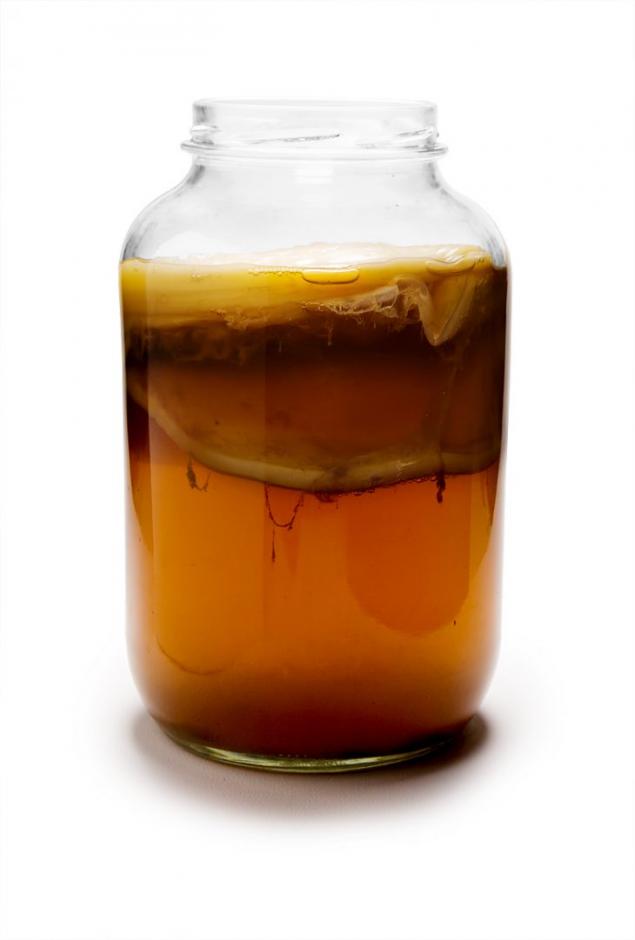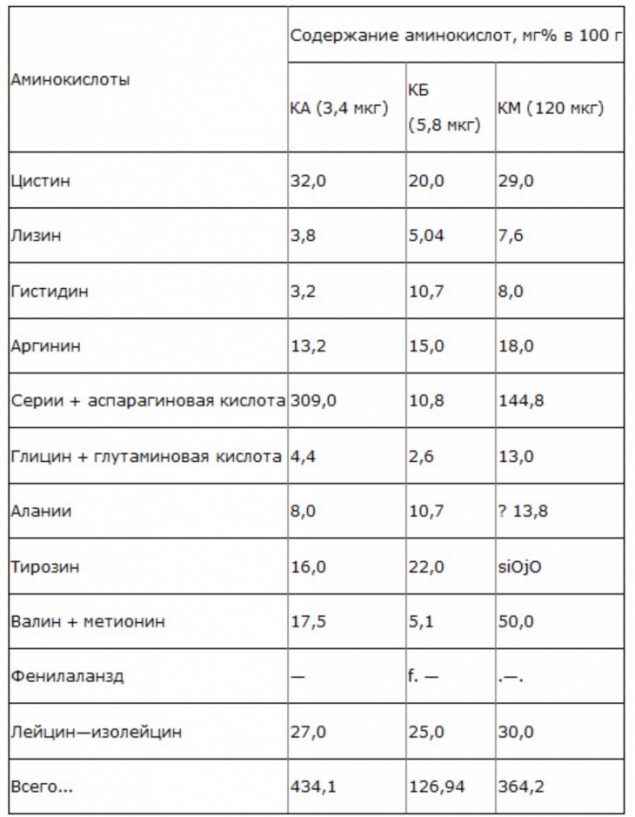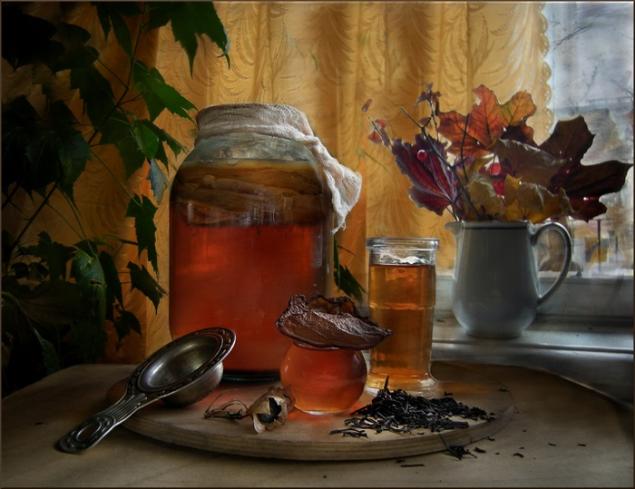What is Kombucha what it is useful for the person, and how to grow it at home
 Bashny.Net
Bashny.Net

Remember this slimy thing in a jar on the windowsill? It still needs to "feed" sweet tea and in any case not to poke a finger. Meet medusomyces or just Kombucha! The website publishes blog article "Sonic" about what Kombucha is and how it benefits man.
What is Kombucha Kombucha, aka Japanese mushroom, medusomyces or even Medusomyces gisevi, at first I was "mushroom" — is a combination of acetic acid microorganisms and colonies of yeast. From the US to Europe and we came up with the fashion to call Kombucha "Kombucha" (from the Japanese word "Kombucha"), but in Spain and southern France it is called "Hongo".
The body of the fungus discoid, dense, smooth and shiny on top, in the center of a living colony of bacteria and fungi, which are sugar processing, and the bottom medusomyces is a growing area consisting of hanging threads, formed by colonies of bacteria. The mushroom constantly grows, filling all the allotted space, so in an industrial scale, his body weight can reach 100 kg.
The more layers of the mushroom, the stronger and healthier but so much harder to manage, harder to remove from the jar, rinse it. If your mushroom "fat", then remove one or two layers and give them to other fans Kombucha, let grow.

Zozhnik.gigrib lives in a transparent glass container, and feeds on the sweet tea. Tea can be any, instead of sugar you can add honey or fructose. You can replace tea herbal infusion, but you can't use the teas and herbs, which contain many essential oils (e.g., sage, pepper, chamomile, wild currants, and several others). Such infusions medusomyces can get sick.
Yeast, living fungus, ferment sugars to form alcohol and carbon dioxide, and fungal bacteria oxidize ethyl alcohol to acetic acid. Through these processes 8% solution of sugar in the tea turns into sweet and sour, slightly carbonated beverage — "tea kvass".
The main components of the infusion medusomyces on the sweet black tea is gluconic acid and kojic, lactic, acetic and carbonic acid, small quantities of citric and malic acid, sugar, caffeine, up to 2.5% ethanol, vitamins b, C, D, PP, aromatic substances, enzymes protease, amylase and catalase.

Don't forget every two weeks to wash the tea jellyfish with warm boiled water. And yet the mushroom can go on vacation if you need to take a break in the production: put it into boiled water or a weak solution of tea, let relax.
Useful properties of the drink Kombucha Tea brew has a slight antimicrobial (antibiotic) action, and thanks to contained enzymes helps to improve digestion. Protease helps break down proteins into amino acids, amylase is involved in the processing of carbohydrates, and catalase destroys toxic hydrogen peroxide, formed during different oxidation processes in the body.
In 1929 a scientist by the name of Germany conducted an experiment with a tea mushroom: knowing that the main active principle Kombucha is gluconic acid, he poisoned Guinea pig, rabbit, dog and cat metanolom. This drug in animals has caused a sharp increase in the level of cholesterol in the blood, and they would certainly have died had he not injected them with the infusion of Kombucha. The drug helped to bring the cholesterol level to normal.
In 50-ies of XX century in Yerevan zoo veterinary Institute the Department of Microbiology Professor Shakarian and associate Professor Danielyan has developed methods to identify the active principle of the infusion of tea fungus, the adsorption on ion-exchange resins. They were able to identify highly effective antibacterial substances: crystalline bactericidin-KA, KB, KM, completely devoid of toxic properties.
Around those same years in the therapeutic properties of Kombucha, especially his concentrate medusine, drew the attention of Professor Naumov. She tested the drug on rabbits, Guinea pigs and white mice. Infecting rabbits with experimental pneumococcal infection diphtheria pigs, mice, Salmonella infection and diphtheria bacteria, it introduces them to the drug Kombucha for several days, and achieved positive results in 80% of cases.
Doctors reasonably believe that the content of medicinal substances in the infusion of tea fungus is small, so it can't replace medications, it can be taken only in the preventive purposes.
The concentration of nutrients in the infusion Kombucha is optimal when its pH is in the range of 4.5 to 3.5. When the pH of the solution less than 3.5 a rapid accumulation of acids. The drink in this stage it is useful to use as many of the useful components, for example, medusin, accumulate during long-term cultivation, but only in diluted form, as kobach already turning into vinegar and its acidity is high.
How to care for Kombucha. If the infusion Kombucha leave room temperature, then 1-2 weeks on the surface of the liquid forms a thin translucent layer — a colony of microorganisms, which with time also turn into adult fungus.
To grow the fungus in this way it is possible, but difficult. Better find a donor, from which you tear off several layers. This is a normal process, mushrooms from such instruments, but in the early days of a young mushroom may lie on the bottom or even a little pribolet and spotty. If after a week or two he will not recover, then throw away and buy another.

From how you care for your Kombucha mushroom is not only the taste but also the chemical composition, and hence the useful properties of the drink. The cycle is as follows: merged infusion, washed mushroom, filled new sweet tea.
Find a home for the fungus: glass jar (capacity 3 litres) with a wide throat. You can't contain the fungus in containers of metals, except stainless steel, as acids are produced by culture, can react with metals.
Prepare the nutrient solution: for every liter of water put 2 teaspoons of black or green tea and 5 tablespoons sugar. Completely dissolve the sugar and strain the mixture of particles of welding should not be. Let the tea cool to room temperature, then pour directly on top of medusomyces.
If your mushroom is still young, add in a bit of tea infusion of the fungus from the banks where he had previously held as a "starter leaven" — about 1/10 of the total volume.
The ripening of the infusion: tightly close the container with the mushroom gauze or paper napkin. So the Kombucha can breathe, but the midges and the dust does not penetrate into the jar. Put the jar in a dark and warm place — the ideal temperature is between 22 to 25 °C. after 4-6 days the infusion is ready to use.
Storage: pour the finished drink into a glass container with a tight lid, and let it ripen in a cool place for another 2-3 days bacteria without access of air cease to function, and the yeast continue to work. Therefore, if the container is tightly closed, the gas arising from the activities of the yeast will not be able to go out and you get a more fizzy drink.
Mushroom in old age it reaches a thickness of a few centimeters, so you can drink the infusion daily straight from the jar where he lives. Don't forget to refill the infusion of a new portion of cold, sweet tea.
Keep the jar with a mushroom in a dark with good natural ventilation. Cold and direct sunlight inhibit the development of Kombucha, so it's best to keep him away from the window.

It is impossible to pour the sugar in the Kombucha and place it in a solution with no dissolved sugar. It causes burns in the form of brown spots. Tea should not be too strong — an over-concentration of tea inhibits the growth of Kombucha. If the top Kombucha started to turn brown — a sign that the fungus starts to die. Sometimes this happens if Kombucha perestoit in solution. Rinse the mushroom, peel off and discard the top layer and start again to care for the pet.
via www.zozhnik.ru/chto-takoe-chajnyj-grib-i-chem-on-polezen/
Tags
See also
The higher the IQ the person, the more slowly narrowed his pupils to light
As per 5 seconds to understand what the other person - a notorious man
What is sustainable development in the modern world
What can you learn about a person by the timbre of his voice
Gyrometer: what is it?
MAIDEN SECRETS: carotene and BEAUTY
15 signs that you are connected with a psychopath
















